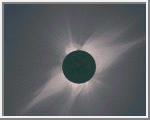|
COMETS EARTH JUPITER KUIPER BELT MARS MERCURY METEORITES NEPTUNE OORT CLOUD PLUTO SATURN SOLAR SYSTEM SPACE SUN URANUS VENUS ORDER PRINTS
PHOTO CATEGORIES SCIENCEVIEWS AMERICAN INDIAN AMPHIBIANS BIRDS BUGS FINE ART FOSSILS THE ISLANDS HISTORICAL PHOTOS MAMMALS OTHER PARKS PLANTS RELIGIOUS REPTILES SCIENCEVIEWS PRINTS
|
Related Document
Download Options
Total solar eclipse of July 11, 1991 as seen from Baja California. This digital mosaic is derived from five individual photographs, each exposed correctly for a different radius in the solar corona. The inner four photographs were taken by Dennis di Cicco (Sky and Telescope) using 1500mm focal length and medium format Ektar 25 film. The outer corona photo (including lunar maria detail) was taken by Gary Emerson (E. E. Barnard Observatory) using a 500mm f/8 telephoto lens and Fujicolor 100 35mm film. These photographs were digitized by David Sime using a CCD scanner at NCAR's High Altitude Observatory. The image scans contain about 2000x2000 pixels and about 1000 usable intensity levels. The digital data were then processed by Steve Albers (Boulder, CO) who developed image processing software designed to seamlessly combine the digitized images while enhancing a wealth of coronal detail. The processing included many steps that started with registering the images. A digital mask was then constructed, allowing each photo to contribute in the annular shaped region where it is properly exposed. Each image was then given a contrast stretch to correct for the film's response and exposure level. This stretch was varied slightly over azimuth to assure a seamless fit. The annular regions from each image were then mosaiced; the resulting intermediate image now approximates what a CCD camera might record if used directly on the corona. This image contains the full dynamic range of the corona, but the range has to be compressed for photographic printing in a way that still shows coronal details in a natural looking fashion. The subsequent image manipulation resembles what a radial density gradient filter might do, except for greater flexibility allowed by the digital approach. The total dynamic range (i.e. radial brightness variation) was reduced, but local contrast was maintained by using a radially dependent contrast stretch. Azimuthal and radially acting spatial filters were then constructed to selectively enhance coronal details on different scales while also suppressing things like film grain. The parameters on these filters were varied over different radii in the corona, and designed to pick out coronal details in much the same way that the human eye does. The resulting 1024x1280 pixel images (in 24 bit color) were photographed (in two stages) off of the monitor of a Stardent computer to produce slides and prints. The mosaic comes close to capturing the visual appearance of the eclipse through high-power binoculars. Interesting features include the star Delta Geminorum above and to the right of the sun as well as a hint of earthshine on the moon's dark side. A slightly different version of the mosaic is featured in the November, 1994 issue of Sky and Telescope. Hint: If you have an 8-bit color monitor, this image may look better displayed in a separate viewer outside of your Web browser. The more colors you can allocate to it, the better. The GIF, JPEG, and even TIFF image formats do not actually give the best results in viewing the eclipse mosaic. The "essence" of the mosaic so far has been best displayed via the photographic slides and prints constructed from the original digital data. |
